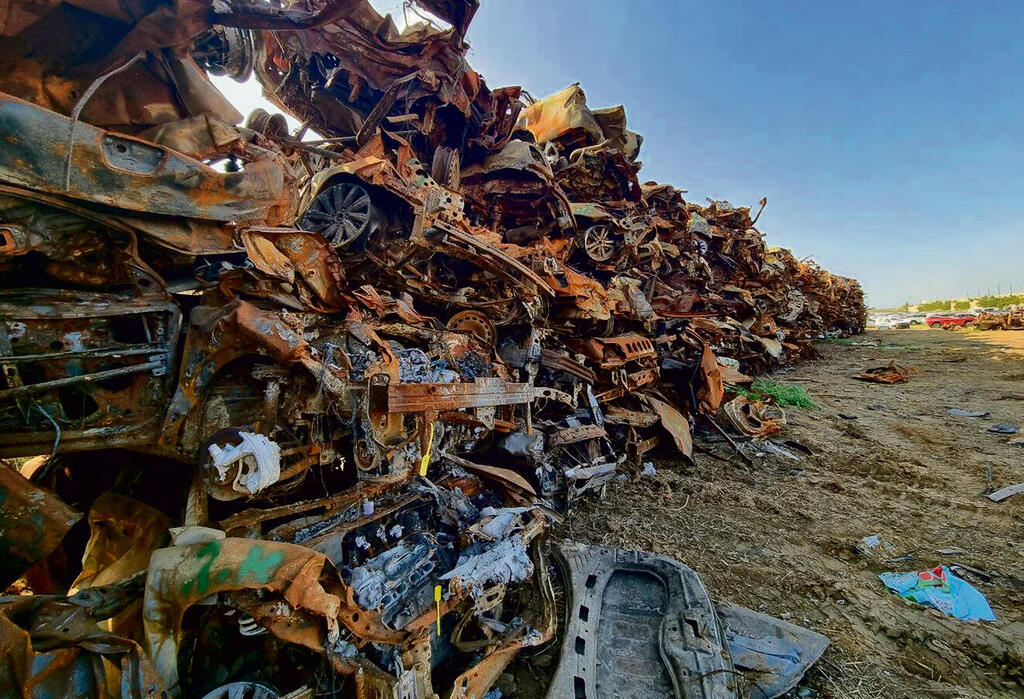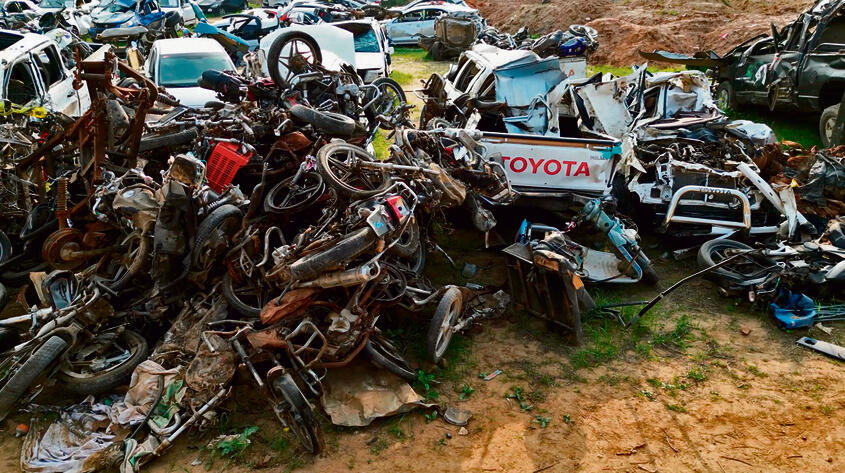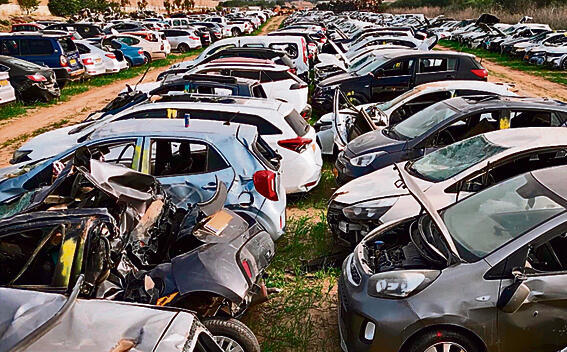The monster now lies dormant. It rests on the edge of a field adjacent to Route 25 near the Sa'ad Junction, surrounded by motorcycle wrecks and white Toyotas. It will no longer take lives or sow death. The formidable war machine of the Nukhba will end its days as a source of spare parts.
Read more:
Shai Ohayon looks with disgust at the black pickup truck. "Look at the monster these damned terrorists created. They placed a weight here, built a platform and mounted a heavy 0.5 machine gun with a shield," he explains.
He shows us one of the bullets found in the pickup, as thick as a human thumb. "The red marking on the tip of the bullet is designed to cause combustion. They fired at everything in their path. Fortunately, the vehicle got stuck in a sand dune and stopped there. I don't even want to imagine what would have happened if it had continued forward," he says.
Not far from us stands an unassuming Hyundai truck. "It came to us in the yard with the other vehicles from Be'eri," Ohayon recounts. "It had no license plates, but when we checked the chassis number, we discovered it was a vehicle from Gaza. Inside, we found a wedding invitation. How absurd is that."
On ordinary days, he is a tax officer. But since October 7, Ohayon has been managing the scrapyard near Moshav Tekuma, where all vehicles damaged during the Hamas attack are concentrated.
Approximately 1,600 vehicles of various types – from sedans to trucks – were brought here and to a smaller field in Sdot Negev Regional Council. Burnt cars, bullet-riddled cars, cars damaged by anti-tank fire, cars crushed under tank treads and cars turned into unrecognizable metal pulp.
Many served as death traps for their passengers, who were caught in Hamas ambushes at junctions or tried to escape the massacre in a hurry. This is not just a scrapyard; it's a massive murder scene.
About 400 vehicles that suffered minor damage were repaired and returned to their owners. The rest were declared total losses, including about 280 cars that were burnt to a crisp.
"If these cars could talk, they would tell us the story of October 7," says Yaron Ben-Naim, the Southern District Manager for Direct Compensation at the Property Tax, who usually serves as the head of the National Enforcement Unit at the Tax Authority.
Ben-Naim and Ohayon are responsible for ensuring that all car owners, or bereaved families, receive compensation for material damage. They often use terms like "reparation" and "damaged," typical for tax officers. But here, they are more than just officials. They are witnesses. Witnesses to horror. The sights, feelings, and smells they experienced at this place, shrouded in a gloomy cloud of death even on sunny days, will never be forgotten.
"When the first cars were brought from the field, the tow truck driver was alone, and I personally, along with one of my employees, helped him unload the vehicles," Ben-Naim recalls.
"I got into one of the cars, sat next to the steering wheel, and suddenly realized that the seat was soaked in blood. The smell inside the car seared into my consciousness and stayed with me for at least a month. I would get into my car in the morning to go to work – and smell blood."
Ohayon points to one of the cars. "This is a vehicle where four people were murdered. ZAKA removed the bodies in the field, but when it arrived here, two of our workers, Yarin and Chaim, found a piece of skull on the driver's seat. A few days ago, we found the remains of a small child in one of the cars."
At the entrance to the compound lies the bloated skeleton of what appears to be a commercial vehicle. "That's the ambulance from the massacre," explains Ohayon.
"Some of the younger guys tried to take shelter in it, but it didn't help them. The terrorists fired an anti-tank missile, and the ambulance caught fire. ZAKA personnel found the remains of eight bodies inside and beneath it. Eventually, DNA traces of no less than 16 victims were found in it."
The vehicles are arranged in rows, like a parking lot of rusted and deformed metal skeletons. ZAKA volunteers went from vehicle to vehicle to clean them of human remains and bring them to Jewish burial. But when a car burns for hours with its occupants inside, that's not enough.
At one point, the idea arose to dig a giant pit and bury all the burnt cars in it. It was soon realized that this was impractical, and that burying hundreds of rusted vehicles could harm the groundwater. The halachic solution found was to extract the ash from inside the cars and bring it for concentrated burial.
The task was assigned to Major (res.) Yaniv Haim Tayeb, the rabbi of the Southern District in the Home Front Command, responsible for casualty and data collection teams. "We arrived here on December 10 and worked for three weeks until we finished extracting all the burnt vehicles," he recounts.
How is the process carried out?
Tayeb explains, "We approach each vehicle with an industrial vacuum cleaner and assess what blocks access to its interior, whether it's the roof or doors that won't open. We have teams from the Home Front Command's rescue units equipped with disc saws and metal cutters. They cut and remove parts that obstruct our work.
“Before we start vacuuming the ash, we manually lift all the large and coarse parts that have fallen inside, and sadly, we also find human remains. Then we vacuum all the ash into plastic containers. Once finished, the yellow forklift you see here transports the vehicle to the scrap heap."
The mentioned scrap heap is a 25-foot-high wall made entirely of burnt skeletons, resembling a set from a post-apocalyptic movie. It's a chilling sight even if you don't know what the passengers went through in their final moments.
"When we finished work, we held a memorial ceremony here," Tayeb recounts. "One of my soldiers prayed the El Malei Rachamim prayer. We said kaddish, read a chapter of Psalms, and sang Hatikvah. In the end, we also asked forgiveness from all the victims in case we hadn't treated them with enough respect. Some of the really tough guys here were moved to tears."
Ohayon: "The first time I cried since October 7 was here at the ceremony."
Many tears have been shed in this dreadful place, especially by families who came to see the cars where their loved ones were murdered. "A family whose son was killed at the massacre came," Ohayon shares. "As soon as the father opened the trunk, they burst into tears. There was the child's jeans, his last memory. Some even came with a psychologist."
What will happen now with all the cars?
Ben-Naim: "The cars that weren't burned will be put up for a centralized auction for use as spare parts. The burned vehicles have been transferred to the Heritage Ministry, and they will be used for documentation and memorial purposes."
Heritage Ministry Director-General Natanel Izak says that specific commemorative actions have not yet been decided. "There are vehicles that we released for display at the Nova Expo, and there have already been requests from bereaved families for private memorials. We understand that the cars must be part of the documentation and memorial of the events of October 7."
Ohayon also looks ahead. "We need to see what grows from here because every crisis also presents an opportunity," he reflects. But until then, there's work waiting, "and not just in this region of the country."
Could you find yourself in the north? "That's not an absurd situation," says Ohayon. "It could happen very soon."





